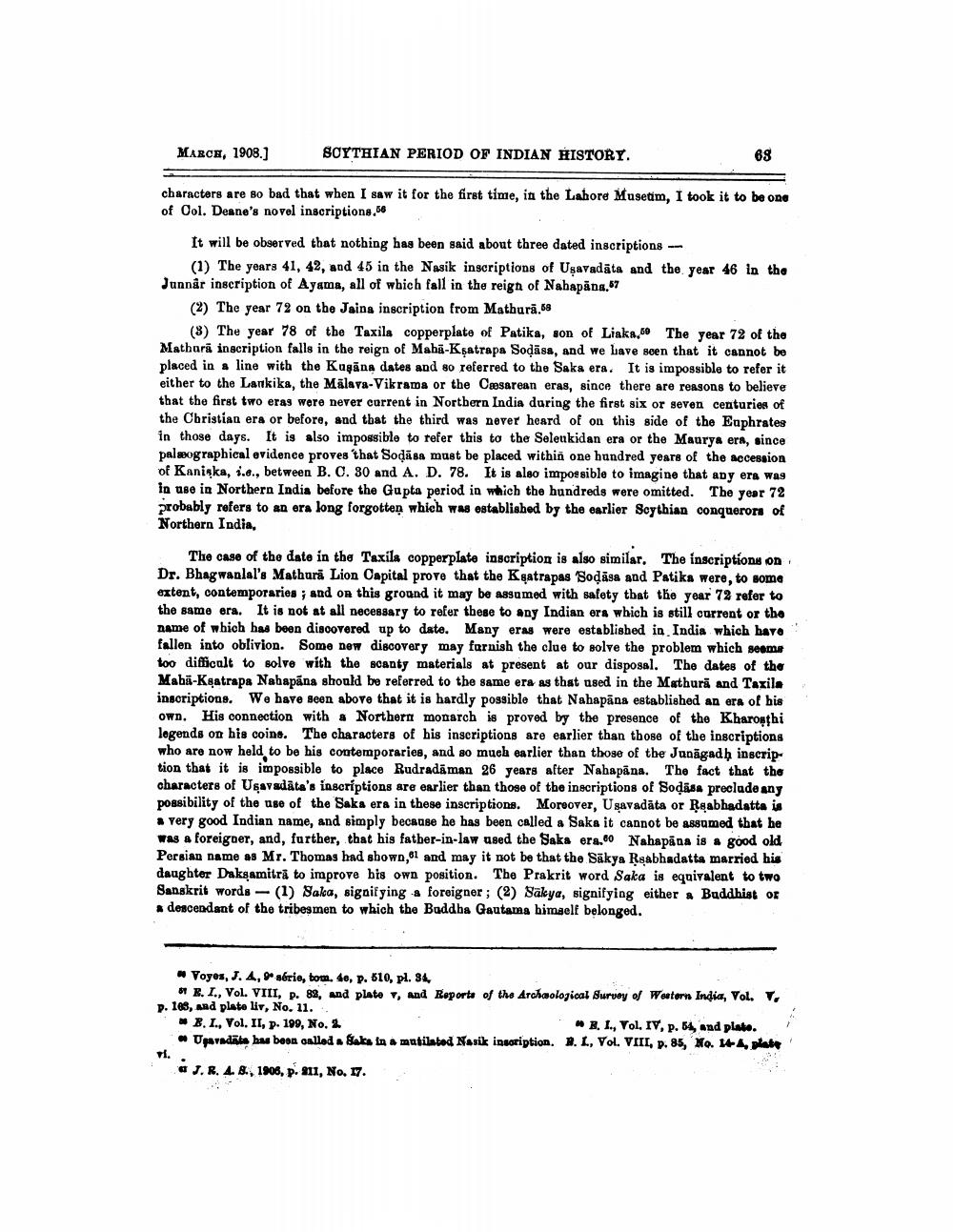________________
MARCH, 1908.)
SCYTHIAN PERIOD OF INDIAN HISTORY.
68
characters are so bad that when I saw it for the first time, in the Lahore Musetim, I took it to be one of Col. Deane's novel inscriptions.66
It will be observed that nothing has been said about three dated inscriptions -
(1) The years 41, 42, and 45 in the Nasik inscriptions of Ugavadāta and the year 46 in the Junnar inscription of Ayama, all of which fall in the reign of Nabapāna.67
(2) The year 72 on the Jaina inscription from Mathura.68
(8) The year 78 of the Taxila copperplate of Patika, son of Liaka.co The year 72 of the Mathara inscription falls in the reign of Maha-Kşatrapa Sodāsa, and we lave seen that it cannot be placed in a line with the Kugāna dates and so referred to the Saka era. It is impossible to refer it either to the Larkika, the Mālava-Vikrama or the Cæsarean eras, since there are reasons to believe that the first two eras were never current in Northern India during the first six or seven centuries of the Christian era or before, and that the third was never heard of on this side of the Euphrates in those days. It is also impossible to refer this to the Seleukidan era or the Maurya era, since palæographical evidence proves that Sodass must be placed within one hundred years of the accession of Kanigka, i..., between B. C. 80 and A. D. 78. It is also impossible to imagine that any ere was in use in Northern India before the Gupta period in which the hundreds were omitted. The year 72 probably refers to an era long forgotten whieh was established by the earlier Scythian conquerors of Northern India,
The case of the date in the Taxila copperplate inscription is also similar. The inscriptions on Dr. Bhagwanlal's Mathura Lion Capital prove that the Ksatrapas Sodāsa and Patika were, to some extent, contemporaries; and on this ground it may be assumed with safety that the year 72 refer to the same era. It is not at all necessary to refer these to any Indian era which is still current or tho name of which has been discovered up to date. Many eras were established in India which havo fallen into oblivion. Some new discovery may farnish the clue to solve the problem which seems too difficult to solve with the scanty materials at present at our disposal. The dates of the Mabā-Kaatrapa Nabapāns should be referred to the same era as that used in the Mathura and Taxila inscriptions. We have seen above that it is hardly possible that Nahapāns established an era of his own. His connection with a Northern monarch is proved by the presence of the Kharoshi legends on his coins. The characters of his inscriptions are earlier than those of the inscriptions who are now held to be his contemporaries, and so much earlier than those of the Junāgadh inscription that it is impossible to place Rudradāman 26 years after Nabapāna. The fact that the characters of Ugavadāta's inscriptions are earlier than those of the inscriptions of Sodasa preclude any possibility of the use of the Saka era in these inscriptions. Moreover, Uşavadāta or Reabhadatta is a very good Indian name, and simply because he has been called a Saka it cannot be assumed that he was a foreigoer, and, further, that his father-in-law used the Saks era. Nahapana is a good old Persian name as Mr. Thomas had shown, and may it not be that the Sākya Rsabhadatta married his daughter Daksamitrā to improve his own position. The Prakrit word Saka is equivalent to two Sanskrit words -(1) Saka, signifying a foreigner ; (2) Sakya, signifying either a Buddhist of * descendant of the tribesmen to which the Buddha Gautama bimaelf belonged.
Yoyes, J. A, série, tom. 46, p. 510, pl. 34, - B. I., VOL. VIII, p. 82, and plate, and Reports of the Archaological Survey of Western India, Vol. V, p. 168, and plate liv, No. 11. *B.I., Vol. II, p. 199, No.
R.I., Vol. IV, p. 64, and plato. Uparadite has been called a saka in mutilated Nasik insoription. R. 1, Vol. VIII, p. 85, No. 14 plate
J. R. A. 8., 1906, p. 211, No. 17.




